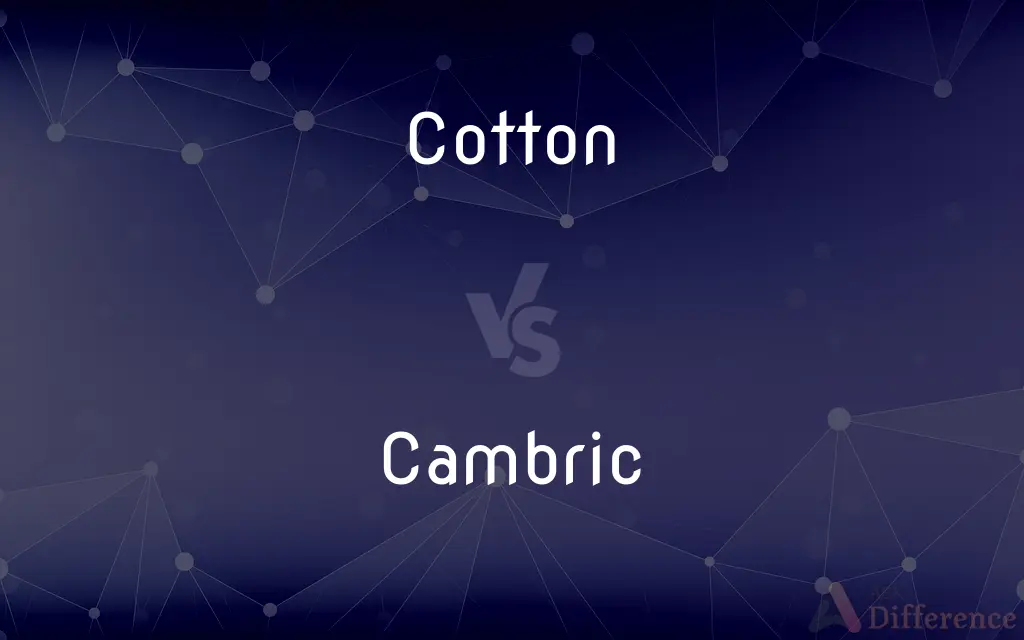Cotton vs. Cambric — What's the Difference?
By Fiza Rafique & Maham Liaqat — Updated on March 27, 2024
Cotton is a soft, fluffy staple fiber that grows in a boll around the seeds of cotton plants, while cambric is a lightweight, closely woven white linen or cotton fabric.

Difference Between Cotton and Cambric
Table of Contents
ADVERTISEMENT
Key Differences
Cotton, derived from cotton plants, is known for its versatility, breathability, and high absorbency, making it ideal for a wide range of textiles from casual clothing to home furnishings. Cambric, on the other hand, is a specific type of fabric made from cotton or linen, characterized by its fine, dense weave that results in a smooth, slightly glossy surface, often used for shirts, handkerchiefs, and lingerie.
While cotton fabric comes in various weights and textures, allowing for its use in everything from heavy canvas to lightweight muslin, cambric is uniformly lightweight and soft, designed for comfort and a delicate feel against the skin. This makes cambric less diverse in its applications compared to cotton.
Cotton's popularity stems from its softness, durability, and natural breathability, which make it a staple for everyday wear and household textiles. Cambric, with its finer weave and lighter weight, is preferred for its luxurious texture and elegance, making it a choice fabric for high-quality dress shirts and undergarments.
The production process for cotton fabric can vary widely, from the traditional hand-weaving methods to modern, industrial weaving technologies, allowing for a vast range of fabric types. Cambric production, however, involves a specific, tightly controlled process to achieve its signature fine, dense weave, highlighting the craftsmanship and quality associated with this fabric.
Cotton's widespread availability and lower cost make it accessible for a broad audience, supporting its use in a variety of applications from budget-friendly clothing to premium home textiles. Cambric, while also accessible, tends to be priced higher due to its refined production process and perceived luxury, targeting a more niche market.
ADVERTISEMENT
Comparison Chart
Origin
Natural fiber from cotton plants
Fine, densely woven fabric made from cotton or linen
Texture
Can vary from soft and fluffy to coarse and rigid
Uniformly smooth and fine with a slight gloss
Use
Versatile; used in clothing, home textiles, industrial applications
Primarily used in high-quality dress shirts, lingerie, and fine linens
Breathability
Highly breathable
Breathable but less so than some looser weave cottons
Price
Ranges from budget to premium
Generally priced higher due to finer quality and production process
Compare with Definitions
Cotton
A natural fiber known for its comfort and breathability.
She prefers cotton dresses in summer for their breathability.
Cambric
Light and comfortable, ideal for undergarments.
Cambric underwear is popular for its lightweight comfort.
Cotton
Versatile in use, from clothing to home décor.
Cotton curtains add a cozy feel to the room.
Cambric
Often used for high-quality dress shirts.
He wears cambric shirts for a polished look.
Cotton
Available in various weaves and weights.
Heavy cotton fabrics are perfect for upholstery.
Cambric
Preferred for luxury linens and fine clothing.
Luxury cambric linens grace the hotel's rooms.
Cotton
Highly absorbent and durable.
Cotton towels are favored for their absorbency and longevity.
Cambric
Characterized by a slightly glossy surface.
The cambric fabric's gloss adds elegance to the garment.
Cotton
Soft and comfortable against the skin.
He chose a soft cotton shirt for daily wear.
Cambric
A fine, dense fabric known for its smooth texture.
Her wedding dress was made of exquisite cambric.
Cotton
Cotton is a soft, fluffy staple fiber that grows in a boll, or protective case, around the seeds of the cotton plants of the genus Gossypium in the mallow family Malvaceae. The fiber is almost pure cellulose.
Cambric
Cambric (US: , UK: or ), or batiste, one of the finest and densest kinds of cloth, is a lightweight plain-weave cloth, originally from the French commune of Cambrai, woven greige (neither bleached nor dyed), then bleached, piece-dyed and often glazed or calendered. Initially it was made of linen; later, the term came to be applied to cotton fabrics as well.
Cotton
Any of various shrubby plants of the genus Gossypium, having showy flowers and grown for the soft white downy fibers surrounding oil-rich seeds.
Cambric
A finely woven white linen or cotton fabric.
Cotton
The fiber of any of these plants, used in making textiles and other products.
Cambric
A finely-woven fabric made originally from linen but often now from cotton.
Cotton
Thread or cloth manufactured from the fiber of these plants.
Cambric
A fine, thin, and white fabric made of flax or linen.
He hath ribbons of all the colors i' the rainbow; . . . inkles, caddises, cambrics, lawns.
Cotton
Any of various soft downy substances produced by other plants, as on the seeds of a cottonwood.
Cambric
A fabric made, in imitation of linen cambric, of fine, hardspun cotton, often with figures of various colors; - also called cotton cambric, and cambric muslin.
Cotton
To take a liking; attempt to be friendly
A dog that didn't cotton to strangers.
An administration that will cotton up to the most repressive of regimes.
Cambric
A finely woven white linen
Cotton
To come to understand. Often used with to or onto
"The German bosses ... never cottoned to such changes" (N.R. Kleinfield).
Cotton
Gossypium, a genus of plant used as a source of cotton fiber.
Cotton
Any plant that encases its seed in a thin fiber that is harvested and used as a fabric or cloth.
Cotton
Any fiber similar in appearance and use to Gossypium fiber.
Cotton
(textiles) The textile made from the fiber harvested from a cotton plant, especially Gossypium.
Cotton
(countable) An item of clothing made from cotton.
Cotton
Made of cotton.
Cotton
(transitive) To provide with cotton.
Cotton
To supply with a cotton wick.
Cotton
To fill with a wad of cotton.
Cotton
(horticulture) To wrap with a protective layer of cotton fabric.
Cotton
To cover walls with fabric.
Cotton
(tar and cotton) To cover with cotton bolls over a layer of tar (analogous to tar and feather )
Cotton
To make or become cotton-like
Cotton
To raise a nap, providing with a soft, cottony texture.
Cotton
To develop a porous, cottony texture.
Cotton
To give the appearance of being dotted with cotton balls.
Cotton
To enshroud with a layer of whiteness.
Cotton
To protect from harsh stimuli, coddle, or muffle.
Cotton
To rub or burnish with cotton.
Cotton
To get on with someone or something; to have a good relationship with someone.
Cotton
A soft, downy substance, resembling fine wool, consisting of the unicellular twisted hairs which grow on the seeds of the cotton plant. Long-staple cotton has a fiber sometimes almost two inches long; short-staple, from two thirds of an inch to an inch and a half.
Cotton
The cotton plant. See Cotten plant, below.
Cotton
Cloth made of cotton.
Cotton
To rise with a regular nap, as cloth does.
It cottons well; it can not choose but bearA pretty nap.
Cotton
To go on prosperously; to succeed.
New, Hephestion, does not this matter cotton as I would?
Cotton
To unite; to agree; to make friends; - usually followed by with.
A quarrel will end in one of you being turned off, in which case it will not be easy to cotton with another.
Didst see, Frank, how the old goldsmith cottoned in with his beggarly companion?
Cotton
To take a liking to; to stick to one as cotton; - used with to.
Cotton
Silky fibers from cotton plants in their raw state
Cotton
Fabric woven from cotton fibers
Cotton
Erect bushy mallow plant or small tree bearing bolls containing seeds with many long hairy fibers
Cotton
Thread made of cotton fibers
Cotton
Take a liking to;
Cotton to something
Common Curiosities
What is cotton?
Cotton is a natural, soft fiber that grows around the seeds of cotton plants, used to make a wide variety of textiles.
How does the breathability of cotton compare to cambric?
Cotton is generally more breathable due to its variety of weaves, whereas cambric, with its denser weave, offers slightly less breathability.
What is cambric?
Cambric is a fine, tightly woven fabric made from cotton or linen, known for its smooth, lightweight, and slightly glossy texture.
Can cambric be made from both cotton and linen?
Yes, cambric can be made from either cotton or linen, depending on the desired finish and texture.
What are common uses of cotton?
Cotton is used for a vast array of products, including clothing, bedding, towels, and industrial materials.
Is cambric more expensive than cotton?
Typically, cambric is priced higher than most cotton fabrics due to its fine quality and the complexity of its production process.
Is cotton suitable for all seasons?
Yes, cotton's versatility makes it suitable for clothing and textiles in all seasons.
Are there different types of cotton fabric?
Yes, cotton fabric comes in a wide range of types, including muslin, canvas, and denim, each with unique characteristics.
Why is cambric considered luxurious?
Cambric is considered luxurious because of its fine weave, smooth texture, and slightly glossy finish, which are associated with high-quality textiles.
How do you care for cambric fabrics?
Cambric fabrics may require gentle washing and air drying to maintain their texture and quality.
What are common uses of cambric?
Cambric is commonly used for fine dress shirts, luxury linens, and delicate undergarments.
What distinguishes cambric from other cotton fabrics?
Cambric is distinguished by its fine, tight weave, smooth texture, and light weight, setting it apart from other cotton fabrics.
How do you care for cotton fabrics?
Cotton fabrics generally require simple care, including machine washing and tumble drying on low heat.
Is cambric good for summer wear?
Yes, cambric's lightweight and comfortable nature make it ideal for summer clothing, especially dress shirts.
Can cotton be organic?
Yes, organic cotton is grown without the use of synthetic pesticides and fertilizers, offering an eco-friendly option.
Share Your Discovery

Previous Comparison
Pane vs. Panel
Next Comparison
Cool vs. ClassyAuthor Spotlight
Written by
Fiza RafiqueFiza Rafique is a skilled content writer at AskDifference.com, where she meticulously refines and enhances written pieces. Drawing from her vast editorial expertise, Fiza ensures clarity, accuracy, and precision in every article. Passionate about language, she continually seeks to elevate the quality of content for readers worldwide.
Co-written by
Maham Liaqat














































